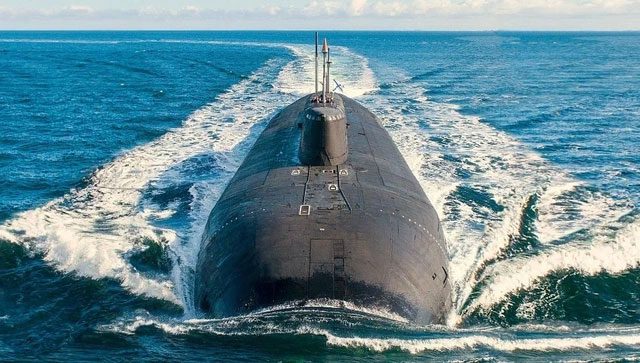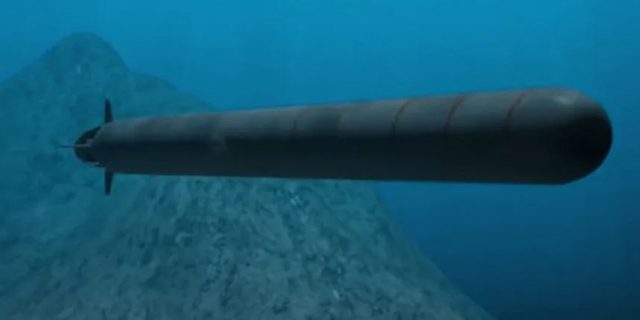Nine months ago, Sevmash successfully “delivered” the largest nuclear submarine of the Russian Navy, named K-329 Belgorod, measuring 184 meters in length and 18.2 meters in width.
The formidable power of the K-329 Belgorod, Russia’s largest nuclear submarine, lies in its ability to carry up to 6 Poseidon nuclear torpedoes, along with 6 533 mm torpedo launch tubes, as reported by Naval Technology.
According to the plan, the K-329 Belgorod submarine is set to be delivered to the Russian Pacific Fleet in 2025.

Sevmash shipyard delivers the Belgorod nuclear submarine (K-329) to the Russian Navy. (Photo: Militaryleak).

3D rendering of the Russian K-329 Belgorod submarine.
In a specialized analysis titled Nuclear Weapons published in early February 2024, the Federation of American Scientists (FAS) noted that Russia is undertaking a decades-long modernization program for its nuclear forces, replacing Soviet-era missiles, aircraft, and submarines with new systems.
As part of this project, the Russian Navy is currently modernizing its fleet of nuclear-powered ballistic missile submarines (SSBN) and constructing new nuclear-powered guided missile submarines (SSGNs), along with other non-strategic naval systems capable of nuclear capabilities. The final delivery of these new strategic and non-strategic submarines to the Northern and Pacific Fleets is expected to be completed in the early 2030s.
According to FAS observations, the Russian Navy is also building submarines specifically configured to carry long-range, nuclear-armed torpedoes known as Poseidon.
In fact, the K-329 Belgorod is the first Russian submarine equipped with Poseidon torpedoes. The second submarine, Project 09851 Khabarovsk, is in the final stages of construction at the Sevmash shipyard and will also carry up to 6 Poseidon torpedoes. Another specially configured submarine is expected to be delivered to the Russian Navy in 2027, bringing the total to at least three Russian submarines capable of carrying Poseidon.
The Defense Post (based in Washington D.C., USA) quoted Russian President Vladimir Putin stating that Poseidon will essentially be a new type of nuclear weapon.
The destructive power of the Poseidon torpedo.
First announced in 2018, this weapon was previously known as “Status-6” and KANYON and was recently renamed Poseidon. Poseidon won over two other names, Aurora and Skif, in a naming contest organized by the Russian Ministry of Defense.
The Poseidon torpedo is named after the Greek god Poseidon, one of the 12 Olympian gods, who ruled the sea and had the power to shake the earth.
True to its name, the power of the Poseidon torpedo has been described by American media as “unstoppable.”

Russian Poseidon torpedo. (Photo: Russian Ministry of Defense/Covert Shores).
According to Naval Technology, the Poseidon torpedo is an autonomous, nuclear-powered, intercontinental torpedo measuring 19.8 meters in length and 1.9 meters in diameter. It is the largest torpedo ever developed by any country in the world. This weapon can operate at a maximum depth of 1,000 meters and can run for approximately 100 hours.
Poseidon is designed to attack enemy coastal targets from thousands of kilometers away. With its nuclear power, Poseidon can reach speeds of up to 70 knots (129 km/h) – fast enough to evade existing torpedoes, making underwater interception extremely difficult.
Popular Mechanics reported that no country has ever equipped a weapon capable of moving at 80 knots underwater, so currently, no effective defense measures exist.
Experts believe that the Poseidon torpedo is equipped with a 2-megaton thermonuclear warhead, the largest warhead deployed by any country in decades. This equates to 2,000 kilotons of TNT.
The two atomic bombs, Little Boy and Fat Man, dropped by the United States on the Japanese cities of Hiroshima and Nagasaki in 1945, had explosive yields of 15 and 21 kilotons, respectively. This means that the power of the Poseidon torpedo is 133 times greater than that of the Little Boy nuclear bomb.
A 2-megaton thermonuclear bomb detonated on land would create a fireball with a diameter of 1,600 meters and cause third-degree burns at a distance of 14,000 meters. If detonated over New York City, such a bomb would kill 1.7 million people and injure another 2 million, Popular Mechanics assumes.
In a 2023 article by Naval Technology, initial reports indicated that the Poseidon torpedo could even be equipped with an even larger thermonuclear warhead of up to 100 megatons, equivalent to 100,000 kilotons of TNT [6,666 times more than the Little Boy bomb].
This figure is twice that of the Tsar Bomba (Czar Bomb, also known as the Tsar Bomb) – an aerial thermonuclear bomb developed and tested by the Soviet Union and the most powerful nuclear weapon ever created.
The 100-megaton power of the Poseidon torpedo is sufficient to destroy entire coastal cities and cause deeper devastation inland by generating artificial tsunamis filled with radioactive debris.


















































